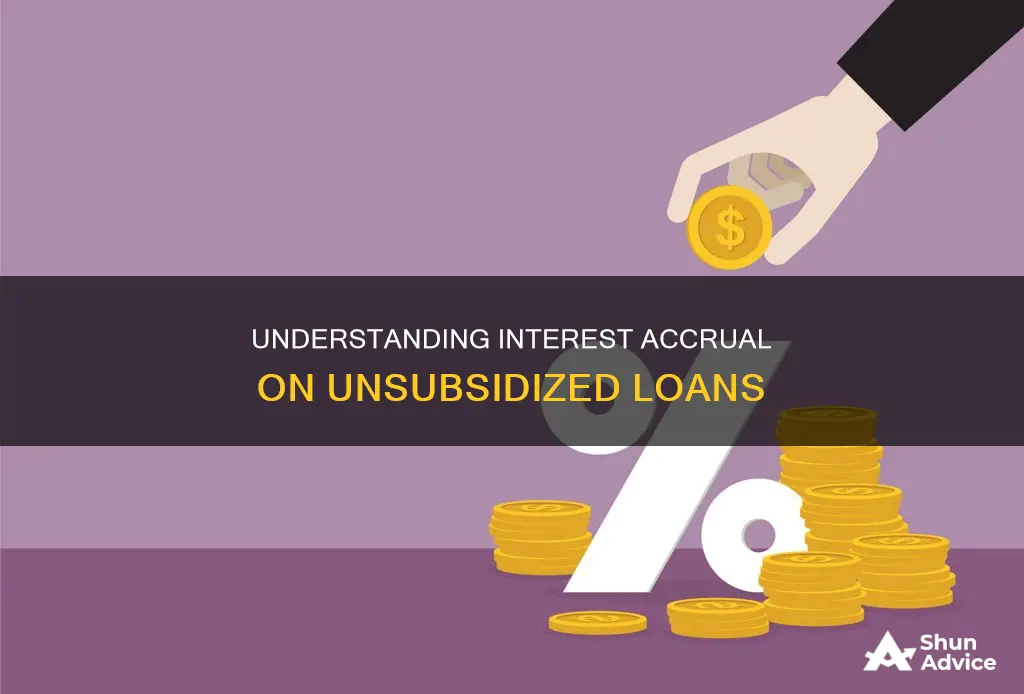
Understanding the difference between subsidized and unsubsidized loans is crucial when considering how interest accrues on your loan. Interest accumulation is a key differentiator between the two types of federal loans, also known as Stafford Loans. While subsidized loans are offered to undergraduate students who demonstrate financial need, unsubsidized loans are available to both undergraduate and graduate students regardless of financial need. The primary distinction lies in the accrual of interest. Interest on unsubsidized loans starts accruing immediately upon disbursement, including while the borrower is in school, during grace periods, and deferments. This means that borrowers are responsible for paying the interest as it accrues from the moment the loan is disbursed, making this debt more expensive than subsidized loans, where the government pays the interest in certain scenarios.
| Characteristics | Values |
|---|---|
| Interest accrual | Interest starts accruing on unsubsidized loans immediately upon disbursement, and during grace periods and deferments. |
| Interest payer | Borrowers are responsible for paying the interest on unsubsidized loans. |
| Interest capitalization | Unpaid interest on unsubsidized loans may be "capitalized", i.e., added to the original principal amount, increasing future interest payments. |
| Eligibility | Unsubsidized loans are available to both undergraduate and graduate students, regardless of financial need. |
| Cost | Unsubsidized loans are more expensive than subsidized loans due to interest accrual during all periods. |
| Application | To apply for federal student loans, individuals must file the FAFSA® every year they are in school. |
What You'll Learn
- Interest accrual on unsubsidized loans starts immediately upon disbursement
- Interest accrues on unsubsidized loans during grace periods
- Interest accrues on unsubsidized loans during deferments
- Unpaid interest on unsubsidized loans may be capitalized
- Unsubsidized loans are available to both undergraduate and graduate students

Interest accrual on unsubsidized loans starts immediately upon disbursement
The main difference between subsidized and unsubsidized loans is who pays the interest while the student is in school. With subsidized loans, the government pays the interest while the student is in school and during the grace period. In contrast, unsubsidized loans do not have this protection, and interest starts accruing immediately upon disbursement, making this type of loan more expensive.
Interest accrual on unsubsidized loans has been paused since the onset of the COVID-19 pandemic in 2020. During this time, interest wasn't accruing on any loans, including unsubsidized loans, which essentially became subsidized debt for some borrowers. However, interest accrual on student loans resumed on September 1, 2023, impacting borrowers with unsubsidized loans.
It's important to note that while students in school are not required to make payments on unsubsidized loans, even while interest accrues, paying at least the interest during these periods can save a significant amount of money. This is because unpaid loan interest will be "capitalized" or added to the original principal amount when the grace period ends, causing the balance to increase over time.
In summary, interest accrual on unsubsidized loans starts immediately upon disbursement, and borrowers are responsible for paying the interest during all periods, including while in school, during the grace period, and during repayment. This can result in higher overall costs compared to subsidized loans, where the government pays the interest under certain conditions.
HR Block: Quick Refund Loans and Advances for Tax Filers
You may want to see also

Interest accrues on unsubsidized loans during grace periods
A grace period on a student loan is a set number of months before your first loan payment is due after you leave school. During this period, you are not required to make monthly payments. However, interest on federal unsubsidized and private student loans will continue to accumulate.
Federal subsidized student loans are covered by the U.S. Department of Education, which pays the interest on these loans until the first payment is due. This means that interest will not accrue on these loans until after the grace period ends.
On the other hand, with federal unsubsidized student loans, interest accrues immediately when you take out the loan. Borrowers must pay all the loan interest, including interest that accumulates during periods of deferment and grace periods. While you are not required to make interest payments on federal unsubsidized loans until the grace period ends, any unpaid interest charges are capitalized, or added to your total loan amount. This means that the interest is added to your principal balance, making your loans much more expensive.
The grace period provides an opportunity to prepare for repaying your student loans, allowing you to settle and find a job. Most federal student loans have a six-month grace period, but this depends on the type of loan you have. Direct Subsidized Loans and Direct Unsubsidized Loans each have a six-month grace period, whereas Direct PLUS Loans do not have grace periods. However, Direct PLUS Loans are eligible for deferment, which can suspend your obligation to repay the loan for six months or longer.
If you can afford to, it is beneficial to start making payments on your student loans during the grace period, even if only in small amounts. This can help prevent your balance from ballooning and can save you thousands of dollars, taking years off your repayment period. Making interest-only payments during the grace period is a good way to determine whether you can afford the full monthly repayment.
HSBC's Loan Sales: What You Need to Know
You may want to see also

Interest accrues on unsubsidized loans during deferments
Deferment allows you to stop making payments on your loan for up to three years, but it does not cancel the loan. Interest on federally subsidized loans does not accrue during the deferment period because the government covers the interest payments. However, interest continues to accrue on unsubsidized loans, such as Direct Unsubsidized and Direct PLUS Loans. The borrower is responsible for the accumulated interest.
Interest on unsubsidized student loans starts accruing the moment the funds are disbursed. Interest accrues daily but is not compounded (added to the balance). Instead, your monthly payment includes the interest for that month plus a portion of the principal. When your loan is in deferment, the daily interest amount remains the same until you begin repaying the loan. Interest is then capitalized (added to the outstanding balance) at the end of the deferment period.
If you have private or unsubsidized federal student loans, deferment can be costly. You can avoid this by paying the interest as it accrues. Forbearance is another way to put off repayments for a period of time, but it is also a temporary fix. An income-driven repayment (IDR) plan may be a better option if you expect long-term financial difficulty.
There are various types of deferments, including in-school, graduate fellowship, military, economic hardship, cancer treatment, and post-enrollment deferments (for Direct PLUS Loans for graduate/professional students).
Understanding Your Rights to Your Spouse's 401(k) Loan
You may want to see also

Unpaid interest on unsubsidized loans may be capitalized
Unsubsidized loans are federal loans that are available to both undergraduate and graduate students, regardless of financial need. With unsubsidized loans, you are responsible for paying the interest from the moment it is disbursed (sent to your school) until the loan is repaid. This means that interest will accrue while you are in school, during your grace period, and during repayment. When you start paying back your unsubsidized loans, your payments will include both the original amount borrowed and the interest that has accrued.
Interest capitalization can cause your loan to cost more than the amount you originally borrowed. Capitalized interest occurs when unpaid interest is added to your student loan balance, resulting in a higher loan balance and larger monthly payments. With unsubsidized loans, interest generally accrues at all times, and it is the borrower's responsibility to pay any interest that accumulates during the life of the loan.
If you choose the interest repayment option for your student loans, your interest should not capitalize because you are paying it as it accrues throughout school. However, if you are making fixed payments or deferring payments until after school, you can try to make small additional payments or pay off some or all of your accrued interest before your separation or grace period ends to avoid or reduce the amount of capitalized interest.
Additionally, interest may continue to accrue during periods of deferment or forbearance. If you request a student loan deferment, your interest will accrue during this period, and any unpaid interest will be capitalized (added to your loan's Current Principal) at the end of the deferment. This new amount will then be used to calculate your interest going forward, resulting in higher borrowing costs and larger monthly payments.
Hospital Bills: Impacting Loan Decisions?
You may want to see also

Unsubsidized loans are available to both undergraduate and graduate students
Unsubsidized loans are federal loans available to both undergraduate and graduate students, regardless of their financial need. Undergraduate students can borrow up to $5,500 per academic year, while independent undergraduates can borrow up to $12,500 per academic year, with no more than $5,500 of that being subsidized. For graduate and professional students, the annual loan limit is only for Direct Unsubsidized Loans, and they are not eligible to receive Direct Subsidized Loans.
The key difference between subsidized and unsubsidized loans is who pays the interest while the student is still in school. With unsubsidized loans, the borrower is responsible for paying the interest from the moment the loan is disbursed. This interest accrues from the moment the loan is disbursed until it is paid in full. Students can choose to pay the interest as they go or allow it to accrue and be capitalized (added to the principal amount of the loan). This capitalization will increase the total amount that needs to be repaid.
Unsubsidized loans are a good option for students who do not qualify for subsidized loans, as there is no need to demonstrate financial need, and students can usually borrow more money. The funds from unsubsidized loans can be used to pay for a graduate degree. Students should only borrow what they need and consider other sources of funding, such as scholarships, savings, and grants, before taking out a loan.
HR Block's Refund Anticipation Loans: What's the Deal?
You may want to see also
Frequently asked questions
Subsidized loans are federal loans available to undergraduate students who can demonstrate financial need. The government pays the interest accrued on these loans while the borrower is in school, during a grace period, and during deferment. Unsubsidized loans, on the other hand, are available to both undergraduate and graduate students regardless of financial need. Interest on these loans starts accruing immediately upon disbursement and must be paid by the borrower.
Interest on unsubsidized loans starts accruing immediately from the moment the loan is disbursed. This includes while the borrower is in school, during any grace period, and during deferment.
Yes, unsubsidized loans accrue interest while the borrower is in school, even if they are enrolled at least half-time. In contrast, subsidized loans do not accrue interest while the borrower is in school, as the government pays the interest during this time.
Yes, unsubsidized loans continue to accrue interest during a grace period after the borrower leaves school. Subsidized loans, on the other hand, do not accrue interest during this time as the government covers the interest.







